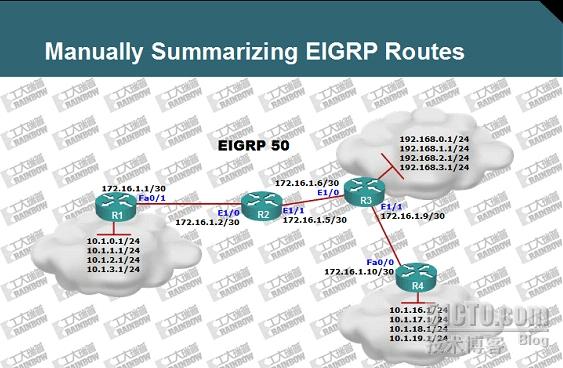EIGRP汇总
转自:http://myhat.blog.51cto.com/391263/193189/
实验目的:
1、理解EIGRP的自动汇总的缺点
2、配置EIGRP手工汇总的方法
A>>>还是老样子,配置一下基础网络连接,保证直接的双方都能PING通。
B>>>在各个路由器上启用EIGRP
本实验借用工大瑞普的拓补图,但内容与工大瑞普无关。特在些声明。谢谢!
在接口上启用EIGRP,我们一定要明白,net后面接的不是网络,它只表示在本地路由器上的哪个接口允许接收与发送EIGRP更新信息。每个接口连接的都是一个网络。
R1>>>>>>
R1(config)#router eig 50
R1(config-router)#no au
R1(config-router)#net 172.16.1.1
R1(config-router)#net 10.1.0.0 0.0.3.255 (在这里我一次性启用四个Loopback口)
R2>>>>>
R2(config)#router eigrp 50
R2(config-router)#no au
R2(config-router)#net 172.16.1.0 (本来这里需要搞两条命令,但是我使用一条就可以解决)
R3>>>>
R3(config)#router eigrp 50
R3(config-router)#net 172.16.1.0
R3(config-router)#no au
R4>>>>
R4(config)#router eigrp 50
R4(config-router)#net 172.16.1.0
R4(config-router)#net 10.1.16.0 0.0.3.255 (老方法,一次性启用多个接口)
R4(config-router)#no au
验证: (这是我们在关闭了路由的自动汇总后,路由器上的EIGRP路由条目,达11条)
R1#show ip route eig
172.16.0.0/30 is subnetted, 3 subnets
D 172.16.1.8 [90/309760] via 172.16.1.2, 00:00:05, FastEthernet0/1
D 172.16.1.4 [90/284160] via 172.16.1.2, 00:02:06, FastEthernet0/1
D 10.1.19.0 [90/437760] via 172.16.1.2, 00:00:02, FastEthernet0/1
D 10.1.18.0 [90/437760] via 172.16.1.2, 00:00:02, FastEthernet0/1
D 10.1.17.0 [90/437760] via 172.16.1.2, 00:00:02, FastEthernet0/1
D 10.1.16.0 [90/437760] via 172.16.1.2, 00:00:02, FastEthernet0/1
R2#show ip route eigrp
D 10.1.19.0 [90/437760] via 172.16.1.6, 00:00:02, FastEthernet0/1
D 10.1.18.0 [90/437760] via 172.16.1.6, 00:00:02, FastEthernet0/1
D 10.1.17.0 [90/437760] via 172.16.1.6, 00:00:02, FastEthernet0/1
D 10.1.16.0 [90/437760] via 172.16.1.6, 00:00:02, FastEthernet0/1
D 10.1.3.0 [90/437760] via 172.16.1.6, 00:04:02, FastEthernet0/0
D 10.1.2.0 [90/437760] via 172.16.1.1, 00:04:02, FastEthernet0/0
D 10.1.1.0 [90/437760] via 172.16.1.1, 00:04:02, FastEthernet0/0
D 10.1.0.0 [90/437760] via 172.16.1.1, 00:04:02, FastEthernet0/0
D 172.16.1.8 [90/307200] via 172.16.1.6, 00:20:35, Ethernet1/1
R4#show ip route eigrp
172.16.0.0/30 is subnetted, 3 subnets
D 172.16.1.4 [90/284160] via 172.16.1.9, 00:04:02, FastEthernet0/0
D 172.16.1.0 [90/309760] via 172.16.1.9, 00:04:02, FastEthernet0/0
10.0.0.0/24 is subnetted, 8 subnets
D 10.1.3.0 [90/437760] via 172.16.1.9, 00:04:02, FastEthernet0/0
D 10.1.2.0 [90/437760] via 172.16.1.9, 00:04:02, FastEthernet0/0
D 10.1.1.0 [90/437760] via 172.16.1.9, 00:04:02, FastEthernet0/0
D 10.1.0.0 [90/437760] via 172.16.1.9, 00:04:02, FastEthernet0/0
小结1:
在这里我没有讲有关自动汇总的坏处,因为看这个拓补图就太明显了。为什么这么说呢? 因为路由器的自动汇总汇总的是主类网络,但是你看看拓补图上,R1与R4的两边的网络都是一个主类网络的子网,如果启用自动汇总将造成网络不通。
当然了,自动汇总也是有好处的,它能减少本地路由器的路由表大小。但是在大多数情况下,手工汇总的效率更高。
2、我们来手工的启用路由汇总:
R1>>>>>>>>>>
R1(config)#in fa0/1
R1(config-if)#ip summary-address eigrp 50 10.1.0.0 255.255.252.0
R4>>>>>>>>>
R4(config)#in fa0/0
R4(config-if)#ip summary-address eigrp 50 10.1.16.0 255.255.252.0
验证:(这是我在做了手工路由汇总后,EIGRP的路由条目为3条。大大的减小了其他路由器的路由条目)
R1#show ip route eig
172.16.0.0/30 is subnetted, 3 subnets
D 172.16.1.8 [90/309760] via 172.16.1.2, 00:04:01, FastEthernet0/1
D 172.16.1.4 [90/284160] via 172.16.1.2, 00:04:01, FastEthernet0/1
10.0.0.0/8 is variably subnetted, 6 subnets, 2 masks
D 10.1.0.0/22 is a summary, 00:04:09, Null0 这一条是我们在做了手工汇总后,路由器自已生成的一条目标为空的列表,它的主要目标是为了防止路由环路。
D 10.1.16.0/22 [90/437760] via 172.16.1.2, 00:02:59, FastEthernet0/1
R2#show ip route eigrp
172.16.0.0/30 is subnetted, 3 subnets
D 172.16.1.8 [90/307200] via 172.16.1.6, 00:23:59, Ethernet1/1
10.0.0.0/22 is subnetted, 2 subnets
D 10.1.0.0 [90/409600] via 172.16.1.1, 00:12:29, Ethernet1/0
D 10.1.16.0 [90/435200] via 172.16.1.6, 00:11:34, Ethernet1/1
R4#show ip route eigrp
172.16.0.0/30 is subnetted, 3 subnets
D 172.16.1.4 [90/284160] via 172.16.1.9, 00:02:38, FastEthernet0/0
D 172.16.1.0 [90/309760] via 172.16.1.9, 00:02:38, FastEthernet0/0
10.0.0.0/8 is variably subnetted, 6 subnets, 2 masks
D 10.1.0.0/22 [90/437760] via 172.16.1.9, 00:02:38, FastEthernet0/0
D 10.1.16.0/22 is a summary, 00:02:45, Null0 这一条是我们在做了手工汇总后,路由器自已生成的一条目标为空的列表,它的主要目标是为了防止路由环路。用于丢弃一些发往10.1.16.0/22这里的包,类似于垃圾箱。